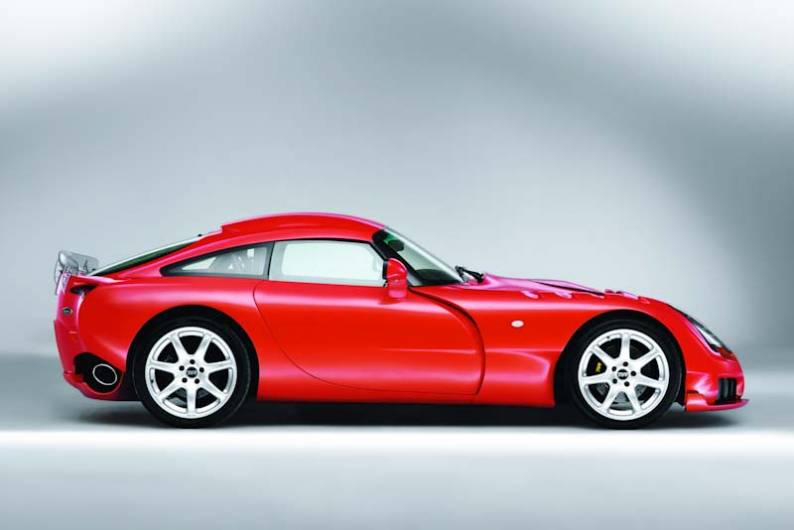
RAC sale – up to 33% off*
• Roadside cover from £5.29 a month†
• We get to most breakdowns in 60 mins or less
• Our patrols fix 4/5 breakdowns on the spot

BY ANDY ENRIGHT
Introduction
Apart from the one offs like the Typhon and Speed 12, the Sagaris will probably be remembered as TVR's final flourish, their range topping showcase when the company went for a rather spectacular burton. Buying any used TVR is an activity best entered into with both eyes open, but now that there is no factory support, it's up there with running with the bulls at Pamplona; exciting and life-changing but hugely risky. Existing TVR owners will scoff at the safe option of a Porsche or BMW but a used Sagaris represents an inevitably bigger involvement.
Models
Models Covered:
(3 dr coupe 4.0 petrol)
History
First unveiled at the Earl's Court MPH03 motor show almost a decade to the day after the Cerbera was first displayed, the Sagaris was a TVR so aggressive it made everything that had gone before appear almost self-effacing. With wild slashes in its T350-derived bodywork and a frontal aspect so mean it made Boxsters dive for cover, the Sagaris was a riot of intriguing details. What's more, the Speed Six engine that powered it had been developed to a stage where many of its teething issues had been overcome. It made a production ready appearance at the 2004 Birmingham motor show.
The Sagaris marked a new development for TVR. Rather than modifying existing road cars for racing use, this is a car that was developed with one eye on the track right from the outset. TVR stressed that the Sagaris wasn't a racing car for the road, but that racing versions would inevitably spawn from its development. Aside from the cooling ducts, there were twin bulges in the roofline to accommodate taller drivers wearing crash helmets and side exiting carbon fibre exhausts to ensure optimal airflow around that rear diffuser. TVR's flagship racing series, the Tuscan Challenge, was rebranded as the 'TVR Challenge' to allow various Blackpool-based cars, including the Sagaris, an entry ticket and the car also campaigned in various GT racing categories.
As with any TVR, the Sagaris was developed on the fly. In response to customer complaints that the car bottomed out with alarming regularity on bumpy B roads, TVR raised the ride height and softened the suspension in 2006. In three years of production, the Sagaris went through three changes of exhaust system. The infamously vague 'Blackpool dyno' at first quoted the Sagaris at 406bhp, then 386bhp and finally 375bhp "in the interests of coping with variable fuel quality." Ostensibly similar cars can also feel quite different due to different differentials being fitted.
What You Get
In order to limit the amount of modifications necessary for racing, TVR has beefed up the T350 chassis, endowing the Sagaris with an even more purposeful stance than the already solidly planted T350. The Sagaris features a wider track than the T350 for grip and stability and is propelled by the 400bhp, straight-six engine from the Tuscan S. Standard equipment includes a full leather and carbon-fibre interior, CD stereo, power steering, limited slip differential, gas discharge headlamps and a two-year unlimited mileage warranty. There's no air conditioning fitted as it was decreed that this would add too much weight. Shaving weight is a Sagaris theme, the cross-woven Vinylester bodywork saving 50-60kg over conventional glassfibre. Peeking from behind the 18-inch multispoke alloy wheels are some serious brakes, 304mm ventilated discs up front and 282mm rotors at the back.
What You Pay
Please fill in the form here for an exact up-to-date information.
What to Look For
Although the Sagaris is by no means the nightmare that, say, early Cerberas were, it's not the most durable sports car ever built. As an example of the rather amateurish way the car was developed, take the aerodynamics, or rather lack of insight into aerodynamics. With no wind tunnel testing done at all, it may come as no surprise to hear that the quoted top speed of the Sagaris is wildly optimistic. Had TVR tried to attain anything like the claimed 195mph in the Sagaris' development, they would have noted that the rear bonnet fixings release at 150mph, as does the tailgate catch.
A recurrent feature of used Sagaris' is damage to the front splitter caused by inadequate damping. All cars will have scrapes but check for cracks to the splitter which will be costly to replace. Misaligned door seals were also a common fault which created a lot of wind noise. Rear three-quarter glass was often poorly bonded. Slow electric windows, air conditioning failures, intermittent faults on coil packs and loose trim parts have also been reported. Clutches tend to last between 10 and 15,000 miles, and many have been uprated from the shoddy original part to a beefier TVRcraft item. Like all TVRs, the gear shift will seem sticky when cold but loosens up when warm. Check for alignment problems and accident damage.
Replacement Parts
Trying to establish definitive parts prices for the Sagaris is tricky, due in no small part to the fact that the vehicle has undergone a series of tiny ad-hoc improvements and changes throughout its lifetime and there is no recognised dealer network. Existing owners report uprated Sagaris clutches to be around £475 plus fitting while the vulnerable front splitter costs around £1,000 including fitting.
On the Road
TVR claims a top speed of around 195mph and 0-60 in 3.7 seconds. Whilst the top end figure is wildly optimistic given that the slipperier and more powerful Porsche 996 Turbo struggles to make 193mph, there's little doubt that the flyweight TVR's acceleration from a standing start is nothing less than concussive. 0-100mph takes just 8.1s.
Value for money has long been a key TVR theme with their wares comparing very favourably on a bhp per pound sterling basis with any of their rivals. You might well expect the likes of Porsche and Ferrari to command a few more shekels than a TVR but cars like the Noble M12 crept up to considerably more than the Bristol Avenue company were charging. Compared to the Sagaris' price, the Noble M12 GTO3-R looked rather expensive and the M400 version even more so. The cabin ambience makes the TVR feel a significantly more special place to be, although it would be a brave person who took both cars to their limits on track in order to finalise a buying decision! The fact that back in 2004 you could afford a Sagaris, a BMW M3 and a Lotus Exige for the price of a Ferrari 360 Challenge Stradale threw the value proposition into clear perspective.
TVR should also be given credit for designing their own engine rather than buying in a third party unit and subsequently modifying it. That Speed Six engine, designed completely in house, is no thud and blunder anachronism either. It's an all-alloy unit with four valves per cylinder and a fully mapped engine management system with some genuinely sophisticated engineering built into the manifolds and catalysts. The individual throttle butterflies on every cylinder seem to hardwire that throttle pedal to the engine, the revs rising and falling almost instantaneously with minimal flywheel effect.
Power assisted steering could be construed as evidence of TVR going soft in its latter days, but customers find their TVRs marginally less uncontrollable with a bit of help from a subservient servo, so there it is. The steering is still very quick and there's a signal lack of airbags anywhere about the cabin, and there's also no anti-lock on the braking system. With tried and tested independent double wishbones and coil over gas dampers with anti roll bars, the suspension is eminently tuneable. The incremental development incurred in the creation of the Sagaris largely hinged around weight saving and styling, two areas where TVR never failed to excel.
Overall
Only the hedonistic, the brave, or the intensely calculating will sign up for a used TVR Sagaris. With the withdrawal of factory support, buying a Sagaris is not for the dilettante. As such, this is a tough car to recommend but one that's almost impossible not to feel a strong pang of desire for. Gambling on a three or six month ownership tenure is just so tempting.







